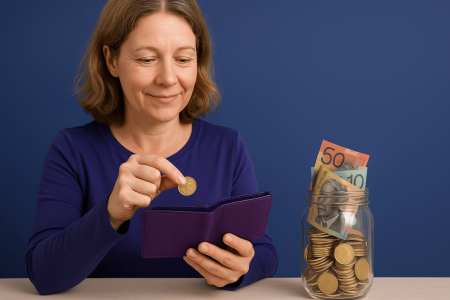Last Chance for a $500 ATO Super Boost – Older Aussies Urged to Act Now
- Replies 0
If you’re aged 60 or over and earning a bit of money, the ATO has a little-known bonus just for you: up to $500 of “free money” into your super. But you have to act fast – the 30 June deadline to qualify for this year’s payment is looming.
This $500 boost isn’t an electricity bill rebate or cost-of-living payment – it’s a superannuation co‑contribution scheme run by the ATO, designed to help low‑ and middle‑income earners build retirement savings. Essentially, the Government will top up your personal after‑tax contributions to super by up to 50 cents on the dollar, for a maximum of $500.
If you’re scratching your head, don’t worry – we’ve broken it down. In simple terms: put some of your own money (up to $1,000) into super by June 30, and the ATO will add up to $500. That’s a 50% return on your contribution, tax‑free.
For many retirees or pre‑retirees on tight incomes, that’s a rare high-yield deposit. Even if you can only spare a few hundred dollars, you’ll still get a percentage boost. As H&R Block explains, “If your total income…does not exceed $45,400 in 2024–25, the government will match your eligible super contributions by 50 cents per dollar up to a maximum of $500”. (The contribution tapers off as income rises, cutting out at $60,400 for the 2024‑25 year.)
Who Can Get the $500? Eligibility Rules
Not everyone qualifies, so let’s check the key requirements. You must have:- Made at least one personal (after‑tax) contribution to a complying super fund in the 2024–25 year (by 30 June).
- Total income in 2024–25 below the upper threshold (around $60,400). To receive the full $500, your income must be $45,400 or less. Between $45,400 and $60,400 the top-up is smaller (for example, at $50,000 income it’s about $347 on a $694 contribution).
- At least 10% of your income from employment or running a business. (Unfortunately, Centrelink pensions or passive income like dividends don’t count toward this test. So if your only income is an Age Pension or investments, you likely won’t qualify.)
- Lodged your tax return for 2024–25. The ATO requires that you have filed a return for the year of the contribution.
- Been under age 71 at 30 June 2025. (Once you turn 71, this scheme ends.)
- A total super balance below the general transfer balance cap at 30 June 2024, and you mustn’t have exceeded your non‑concessional (after-tax) contribution cap.
In short: yes to an after‑tax super top-up this year, yes to modest income, yes to the 10% work‑income rule, and yes to lodging a tax return. Also, very importantly, make sure your super fund has your Tax File Number (TFN) on record – otherwise the ATO won’t pay it in. If in doubt, give your super provider a quick call to check your TFN is registered.
Experts agree this is worth a look. A recent Firstlinks editorial reminds readers: “Check your eligibility for the co-contribution – it’s a good way to boost your super”. In other words, if you meet the criteria, it truly is a free top-up on your retirement savings.
How Much Will You Get? (Examples)
The exact bonus depends on both your income and how much you contribute. Here’s the basic idea:- Income ≤ $45,400 (2024–25): contribute $1,000 after tax → get the full $500 back.
- Income ≈ $50,000: contribute ~$694 after tax → get about $347 back.
- Income ≥ $60,400: you won’t get any co-contribution (above this, it cuts out).
- Income in between: government tops up at 50c per dollar, tapering down. (Even if your calculated share is under $20, the ATO guarantees a minimum of $20 if you qualify.)
This table (based on ATO rules) illustrates a few cases:
| Your total income (2024–25) | Your after‑tax contribution | Government co-contribution |
| Up to $45,400 | $1,000 | $500 (max) |
| $50,000 | $694 | $347 |
| $58,000 (approx.) | $40 | ~$20 (minimum) |
| Above $60,400 | – | $0 |
How to Claim: Steps You Need to Take
You don’t need to apply or fill in any special form for this rebate – the ATO handles it automatically when you do your tax return. But you do need to do the right things:- Make the personal contribution: Transfer money from your bank account to your super fund before June 30. It must be a non‑concessional (after‑tax) contribution – not an employer or salary‑sacrifice payment, and not a contribution you intend to claim as a tax deduction. (If you’re worried about timing, be aware that some funds take days to process. UniSuper’s Derek Gascoigne warns, “Doing it on the 30th of June doesn’t guarantee that the contribution will register in your account on that day to qualify you for the co-contribution.”. A safe bet is to pay at least 1–2 weeks before 30 June.)
- Check eligibility: Before contributing, double-check that you meet the rules above – especially the income and age tests. (You can use the ATO’s online calculator to estimate your rebate.)
- Ensure TFN on file: Confirm your super fund has your Tax File Number. If not, provide it. The ATO won’t deposit the co-contribution if your TFN is missing.
- Lodge your tax return: After 30 June, lodge your 2024–25 tax return as usual by the due date (generally 31 Oct 2025, or Feb 2026 if an accountant lodges it). When you lodge, the ATO automatically checks your eligibility and (if you qualify) deposits the co-contribution into your super account for that year. You don’t have to claim it in a form – just make sure your contribution was made and tax return filed.
- Watch for payment: If eligible, you should see the $20–$500 payment hit your super account sometime between November 2025 and January 2026. (Check with your fund if needed.)
UniSuper’s tip: Don’t wait until the last day. Gascoigne from UniSuper advises giving the system a buffer – do your super top-up at least a week or two before June 30 so it clears on time. Many industry funds recommend contributions hit their account by mid‑June, since some clearing houses queue payments. In practice, most accountants suggest getting it done by 20 June at the latest. That way you avoid any chance of “too late” paperwork.
What It Means for Your Retirement
For older Australians watching the budget, this might seem like a modest deal, but it can have an outsized impact on your long-term nest egg. A guaranteed 50% return (up to $500) on your super contribution is hard to beat these days – far better than any bank term‑deposit or savings interest (even if current savings rates are slightly higher than a year ago, they’re still often under 5%).In real terms, a $500 boost will add compounding interest and tax benefits over time. Remember, money in super enjoys tax concessions: personal after-tax contributions aren’t taxed on entry, and earnings in the fund are taxed at just 15%.
For many seniors on fixed incomes, every dollar counts. If you’re still working part-time, babysitting grandkids, or running a small business, this is a no-brainer way to pad your retirement fund.
Financial advisor notes: “Given tight budgets, boosting super with this government top-up is an opportunity you don’t want to leave on the table,” as highlighted by industry commentators. Even making smaller, regular contributions can help: one adviser suggests something like $20 a week (about $1,040 a year) so you hit the $500 cap without feeling a pinch.
Of course, there’s a trade-off: anything you put into super now is essentially locked away until you’re at retirement age (usually 60 or over). This isn’t extra cash in your pocket today.
However, if you truly don’t need that money to cover bills right now, using this scheme is almost like getting a half-price top-up on your retirement. For example, it’s better than earning 0% interest on money under the mattress!
This scheme is also part of a wider push by government to ease living costs. In fact, the federal Budget introduced other energy bill rebates (such as a $300 credit to all households from July 2024 and a $500 electricity rebate for seniors last year). But make no mistake: this $500 ATO rebate is separate from those energy programs. It doesn’t reduce your power bill – instead, it boosts your retirement savings. In tight economic times, such “free money” can be a useful shock absorber in your budget.
For older retirees, one question is whether you even qualify, since the 10% work‑income test can trip up pensioners. If you earn some income from part-time work or self-employment, you may still be eligible. Even a side gig or consulting job could suffice to hit that 10% mark, unlocking a neat windfall. (On the flip side, if you’re fully retired on pension-only income, then no, this program won’t help you.)
Beyond this co-contribution, financial experts encourage seniors to review all possible means of boosting retirement funds. For example, spouse contributions or tax deductions might be available if your partner earns less.
But the key is: don’t overlook the obvious. The ATO will literally give you money here if you do the simplest thing of topping up super. As CPA Australia points out, think carefully before dipping into super – because leaving money in can trigger this bonus automatically.
In context, $500 may not sound like much against rising costs, but small boosts add up. For perspective, the Australian Bureau of Statistics recently noted electricity price pressures as a major concern for seniors, and governments have poured billions into rebates. This super scheme is another piece of the puzzle, encouraging Australians to save rather than spend.
For some, that extra $500 could mean the difference between comfortably affording a family holiday, topping up medication, or simply having one less worry about future bills.
What Should You Do Next?
- Check your super balance and limit: Ensure you’re under contribution caps. Make sure you haven’t already maxed out your non-concessional (after-tax) contributions limit.
- Get your paperwork ready: If you’ve got the income and age sorted, go ahead and move some after-tax funds into super now. Even $500 now is better than $0 later.
- Ask your adviser: If you have a financial planner or accountant, now’s a great time for an end-of-year super chat. They’ll remind you about deadlines (as one advisor quips, “get it in by Monday 23 June to be safe”) and might spot other tax-savvy moves.
- Prepare for tax time: Mark your calendar to lodge your tax return on time. The ATO does the rest, as promised on their website: “When you lodge your tax return, [the ATO] will work out if you’re eligible and pay it to your super account automatically”.
The bigger picture: Getting this $500 is a win on its own, but it’s also a reminder of how savvy planning can make a big difference in retirement. It illustrates a simple point – sometimes the government programs are there, and the only thing standing between you and free money is a quick click and contribution.
What would you do with an extra $500 for your super? It might be small in the grand scheme, but could it help you reach your financial goals faster – or even allow one more mortgage payment or bill to be skipped? The trick is that you have to act now while this offer is on the table.
Will you let this $500 slip away, or will you tuck it into your retirement nest egg? Feel free to share your thoughts or questions below – after all, many of us can benefit from every available “freebie” in these times.









